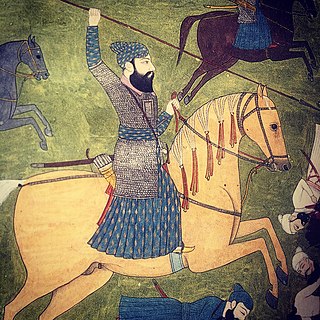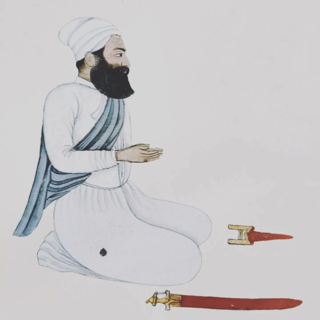
Bhai Mani Singh was an 18th-century Sikh scholar and martyr. He was a childhood companion of Guru Gobind Singh and took the vows of Sikhism when the Guru inaugurated the Khalsa in March 1699. Soon after that, the Guru sent him to Amritsar to take charge of Harmandir Sahib, which had been without a custodian since 1696. He took control and steered the course of Sikh destiny at a critical stage in Sikh history. He was also a teacher of the Gianian Bunga, later becoming known as the "Amritsari Taksal", currently located in Sato Ki Gali.
Guru Nanak founded the Sikh religion in the Punjab region of the northern part of the Indian subcontinent in the 15th century and opposed many traditional practices like fasting, Upanayana, idolatry, caste system, ascetism, azan, economic materialism, and gender discrimination.
The Battle of Bhangani was fought between Guru Gobind Singh's army and Bhim Chand (Kahlur) of Bilaspur on 18 September 1686 or 1688, at Bhangani near Paonta Sahib. An alliance of Rajput Rajas of the Shivalik Hills participated in the engagement on behalf of Bhim Chand of Bilaspur State's side, including the states of Garhwal and Kangra. It was the first battle Guru Gobind Singh, the tenth Sikh Guru, fought at the age of 19.

The second siege of Anandpur, also known as the second battle of Anandpur (1704), was a siege at Anandpur, between Sikhs and the Mughal governors, dispatched by Aurangzeb, Wazir Khan, Dilwaar Kahn and Zaberdast Khan, and aided by the vassal Rajas of the Sivalik Hills which lasted from May 1704 to 19 December 1704.

The Battle of Sri Muktsar Sahib(Muktsar) or Battle of Khidrāne Dee Dhāb took place on 29 December 1705, (29 Poh) following the siege of Anandpur Sahib. In 1704, Anandpur Sahib was under an extended siege by the allied forces of the Mughals and the Hill States of Shivalik.

Banda Singh Bahadur; born Lachman Dev;, was a Sikh warrior and a general of the Khalsa Army. At age 15, he left home to become an ascetic, and was given the name Madho Das Bairagi. He established a monastery at Nānded, on the bank of the river Godāvarī. In 1707, Guru Gobind Singh accepted an invitation to meet Mughal Emperor Bahadur Shah I in southern India, he visited Banda Singh Bahadur in 1708. Banda became disciple of Guru Gobind Singh and was given a new name, Gurbaksh Singh(as written in Mahan Kosh), after the baptism ceremony. He is popularly known as Banda Singh Bahadur. He was given five arrows by the Guru as a blessing for the battles ahead. He came to Khanda, Sonipat and assembled a fighting force and led the struggle against the Mughal Empire.

Binod Singh, a Trehan Khatri and a descendant of Guru Angad, was an army man and disciple of Guru Gobind Singh and was among few Sikhs who accompanied him to Nanded in 1706. In Budha Dal Chronicles, Guru Gobind Singh made Baba Binod Singh the head of the Khalsa.

The Battle of Chappar Chiri, also called Battle of Sirhind, was fought between Mughal Empire and the Sikhs on 12 May 1710 at Chappar Chiri, located 20 kilometers from Sirhind.

The Battle of Rahon was fought between Sikhs and Mughal Empire on 11 October 1710.
The first siege of Anandpur was a thirty-five-day-long siege at Anandpur led by the Rajas of the Sivalik Hills and the Gujar and Ranghar tribesmen against the armies of the Sikh under Guru Gobind Singh.
Sardarni Bibi Susheel Kaur also referred to as Mata Susheel Kaur was the wife of Sikh General Banda Singh Bahadur, who established the first Sikh state and the mother of his son, Ajai Singh. She was the only daughter of Maharaja Udai Singh of Chamba.

The Hill States–Sikh wars, also known as the Sikh–Pahari Raja wars, was a set of battles and conflicts fought by the Sikhs and the rajas (kings) of the Hill States located in the Sivalik Hills.
The Battle of Anandpur was fought between the Sikh forces led by Guru Gobind Singh and the Hill State forces by Alim and Balia Chand. This was the first major battle fought after the formation of the Khalsa.

Alam Singh Nachna, also called Alim Singh, was a warrior in the army of Guru Gobind Singh, and was a Rajput turned Sikh. Sarup Das Bhalla of Mahima Prakash describes him as one of Guru Gobind Singh's constant and closest companions. He is also known for killing a lion single handedly.
The Battle of Anandpur (1685) was fought between the Sikhs and an allied force of rajas of the Hill States of the Sivalik range, specifically Kahlur, Kangra, and Guler.

Brahmin Sikh is a Sikh religious group whose members belong to Brahmin community. They played a key role in the early years of Sikhism. Sometimes they are called Kashmiri Sikhs, for those who are of Kashmiri origin.
The Battle of Anandpur was fought in 1812 by the Sikh forces led by Sodhi Surjan Singh and the Rajput forces of Kahlur led by Raja Mahan Chand.
The Battle of Bilaspur was fought in 1711 by Sikh forces led by Banda Singh Bahadur and the rulers of the Sivalik Hills led by Raja Ajmer Chand of Princely State of Kahlur (Bilaspur).









